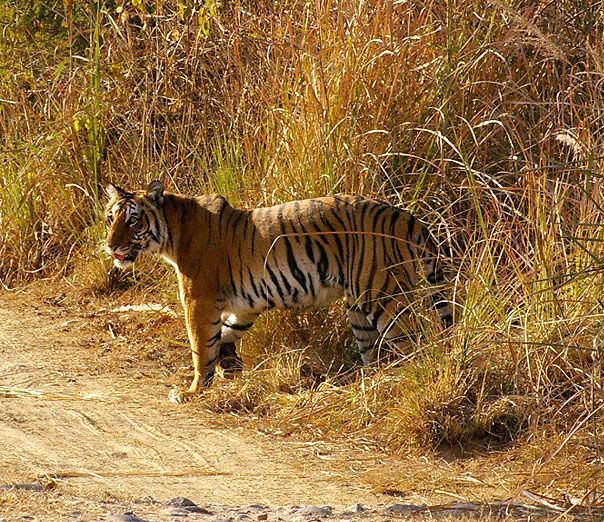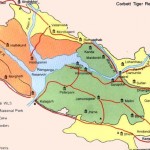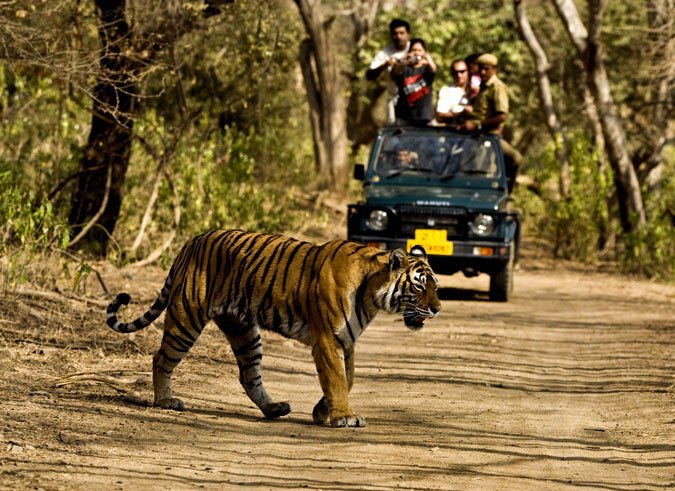
Roar, trumpet and song are some of the properties that perfectly describe Corbett. The incredible charm of the place has attracted nature lovers and wildlife enthusiasts to visit the Jim Corbett National Park and explore the exotic flora and fauna. Jim Corbett National Park is also popular for being the first venue where Project Tiger was inaugurated.


The grasslands are limited and are locally called as Chaurs. Dhikala Chaur is the largest grassland in the area. In the year 1974, the best grasslands namely Beri Chaur and Buxar Chaur got submerged under the Ramganga reservoir. Stretched over an area of 82 sq km, the Ramganga reservoir was established in 1974. Half of the reservoir falls under the Jim Corbett National Park, where the other comes under the Sonanadi Wildlife sanctuary.
- Area: 1,319 sq km (509 sq miles)
- Altitude: 385-1100m above Mean Sea Level
- Geographical Coordinates: 29°25′ to 29°39’N latitude and 78°44′ to 79°07’E longitude
- Rainfall: 1400mm-2800mm
- Temperature: 4°C to 42°C
- Flora: Sal, Sissoo, Kuthber, Chbilla, Semal, Kharpat, Bakli, Bamboo, Khair, Ber, Bel, Dhak, Khingan, Rohini, Pula, etc.
- Mammals: Tiger, Elephant, Sambar, Barking Deer, Rhesus Monkey, Leopard, Cheetal, Hog Deer, Wild Boar Langoor, etc.
- Birds: Peacock, Partridges, Crow, Parakeets, Orioles, Drongo, Woodpeckers, Teals, Cormorants, Jungle Fowl, Kaleej, Vulture, Laughing Thrush, King Fishers, Doves, Ducks, Storks, Seagulls, etc.
- Reptile: Indian Marsh Crocodiles (Mugger), King Cobra, Cobra, Python, Gharials, Common Krait, Russel, Monitor Lizard, etc.
- Pisces: Mahaseer, Kalabasu, Goonch, Kalimuchi, Chilwa, etc.
The Jim Corbett National Park is best to explore the rich flora and fauna. Apart from this, the park is also rich in avifauna. According to the latest survey, over 585 varieties or birds including both native and migratory were recorded in the park. The National Park also provides natural habitat for almost 49 species of diurnal Raptors.
Tourism Zones:
Jim Corbett National Park is a favorite tourism destination for travelers having a deep love for nature and interest in exploring the exotic wildlife. There are 3 differed ways to explore the best of the park, namely Jeep Safari, Canter Safari and Elephant Safari. These safaris are organized to make the tourists aware of the wildlife in the park and also take some perfect pictures of the animals while they enjoying their natural habitat. Throughout the year, there are visitors to the park. The Jim Corbett National Park is divided into five tourism zones such as Dhikala Safari Zone, Durga Devi Safari Zone, Bijrani Safari Zone, Sonanadi safari zone, and Jhirna Safari Zone. These zones are to promote tourism in the park in a more efficient way.
Plan your India wildlife holidays with out tailor-made packages.

Best Time To Visit:
If you wish to see utmost beauty in the Jim Corbett national park, plan your trip between Mid November to Mid June. It is necessary to check the weather and climatic conditions to make the best of the wildlife tour. Generally, the climatic conditions are categorized into major seasons such as Winter (November – February), Summer (March – June) and Spring (July – October).
Also Read about Top 10 Wildlife Sanctuaries and National Park in India.
How To Reach?
Corbett National Park could be reached via roadways, railways and airways. Details of reach route are as mentioned below:
- Roadways: From Delhi, the park is located at a distance of 257 km; From Lucknow, the park is situated at a distance of 430 km; From Ramnagar, the park is located at a distance of 86 km.
- Railway: Ramnagar is the nearest railway station to the Jim Corbett National Park. From Ramnagar, the visitors could easily get shared taxis or could also book a cab to reach the park.
- Airway: Jolly Grant Airport (Dehradun) is the nearest airport to the Jim Corbett National Park located at a distance of 157 km. From the airport, cabs and private taxis are available to carry visitors from the airport to the park.
Contributed by Neelam Talreja

